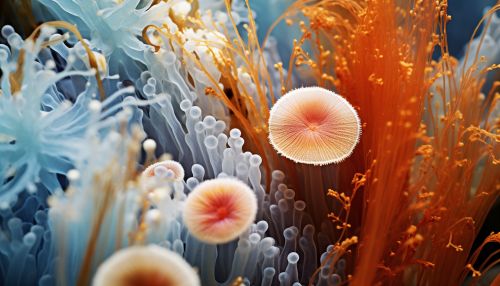Phototrophic archaea
Introduction
Phototrophic archaea, also known as archaebacteria, are a unique group of microorganisms that utilize light energy to carry out their metabolic processes. These organisms are part of the archaea domain, one of the three primary domains of life, the others being bacteria and eukarya. Phototrophic archaea are primarily found in extreme environments such as high-salt, high-temperature, or low-oxygen habitats.


Classification and Characteristics
Phototrophic archaea are classified under the phylum Euryarchaeota, specifically within the class Halobacteria. They are characterized by their ability to perform photosynthesis, a process typically associated with plants and algae. However, unlike plants and algae, phototrophic archaea do not produce oxygen as a byproduct of photosynthesis. Instead, they utilize a unique form of photosynthesis known as anoxygenic photosynthesis.
Anoxygenic Photosynthesis
Anoxygenic photosynthesis is a type of photosynthesis that does not produce oxygen. In this process, phototrophic archaea utilize light energy to convert carbon dioxide into organic compounds, similar to oxygenic photosynthesis. However, instead of water, these organisms use other compounds such as hydrogen, hydrogen sulfide, or small organic molecules as electron donors.
Pigments
Phototrophic archaea contain unique pigments that allow them to capture light energy. These pigments, known as bacteriorhodopsins, are proteins that function as light-driven proton pumps. When light is absorbed by these pigments, it triggers a conformational change in the protein, which pumps protons out of the cell. This creates a proton gradient across the cell membrane, which is used to generate ATP, the energy currency of the cell.
Habitat and Distribution
Phototrophic archaea are extremophiles, meaning they thrive in extreme environments. They are commonly found in high-salt environments such as salt flats and salt pans, where they form a visible pink or red layer on the surface of the water. This coloration is due to the presence of bacteriorhodopsins, which absorb green light and reflect red light. Phototrophic archaea can also be found in other extreme environments such as hot springs, deep-sea hydrothermal vents, and acidic or alkaline lakes.
Ecological Role
Despite their extreme habitats, phototrophic archaea play a significant role in the global carbon cycle. Through their photosynthetic activity, they contribute to the fixation of carbon dioxide, converting it into organic compounds. These compounds can then be utilized by other organisms in the ecosystem, thus contributing to primary production. Additionally, phototrophic archaea also play a role in the sulfur cycle, as some species are capable of reducing sulfate to sulfide.
Research and Applications
Due to their unique metabolic capabilities and extreme habitats, phototrophic archaea are of great interest to researchers. Studies on these organisms can provide insights into the evolution of photosynthesis, the adaptation of life to extreme environments, and the potential for life on other planets. Furthermore, phototrophic archaea and their pigments have potential applications in biotechnology. For example, bacteriorhodopsins have been used in the development of optical devices and bioelectronic systems.
